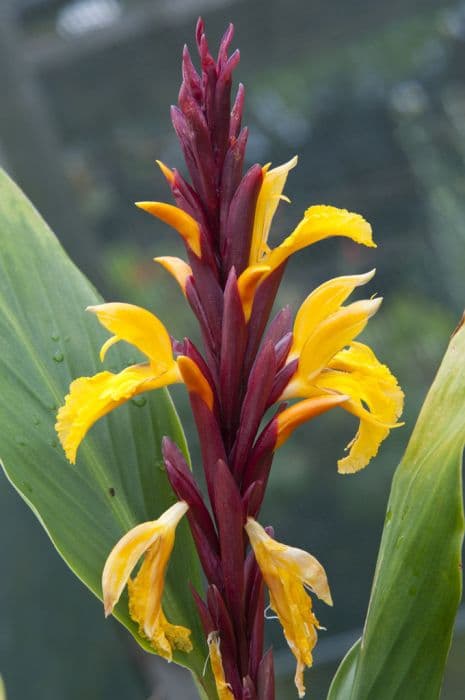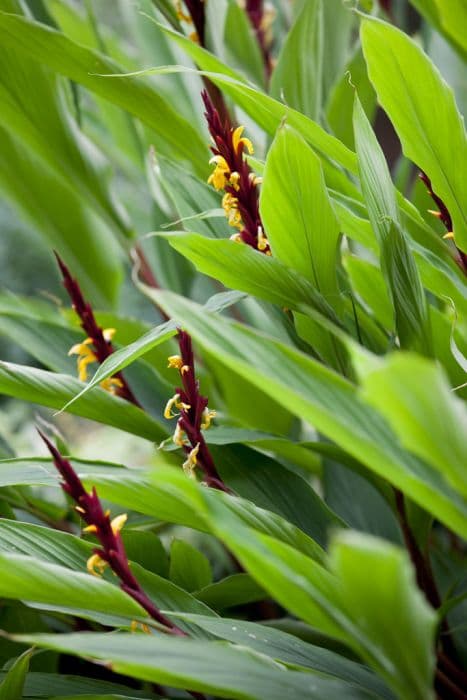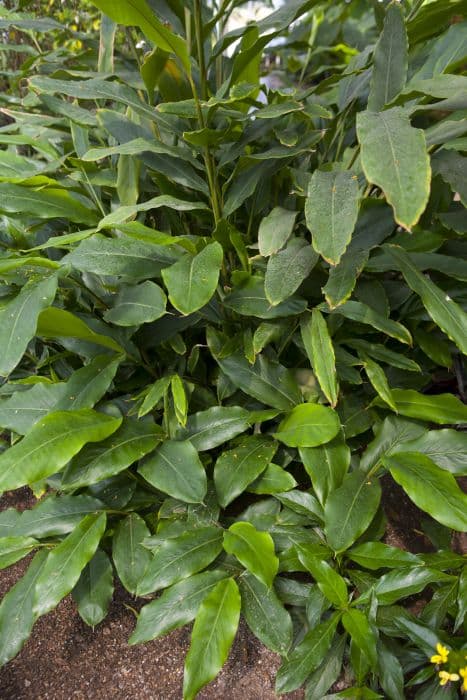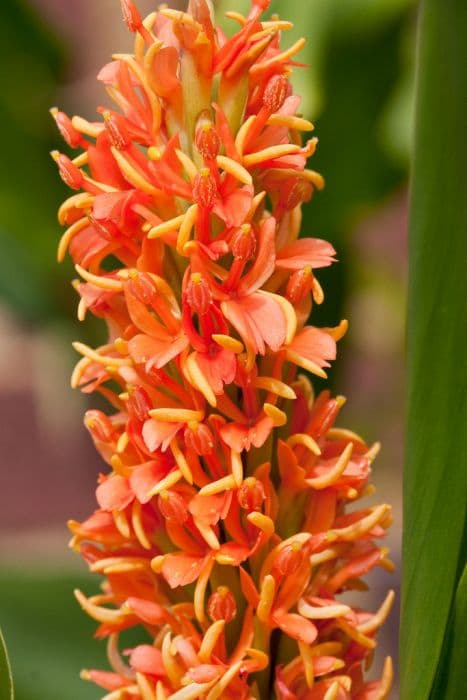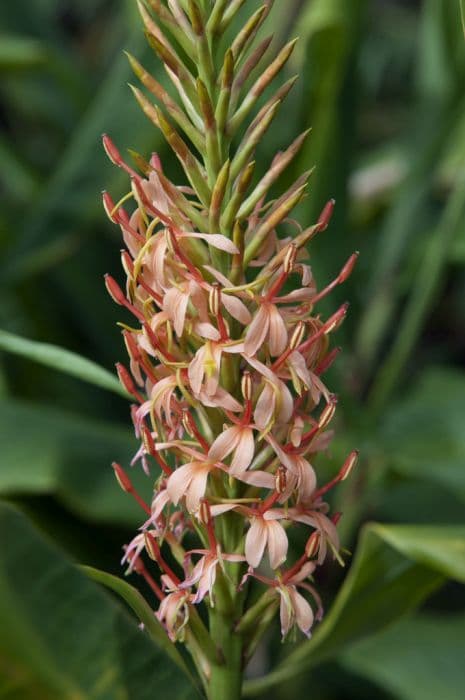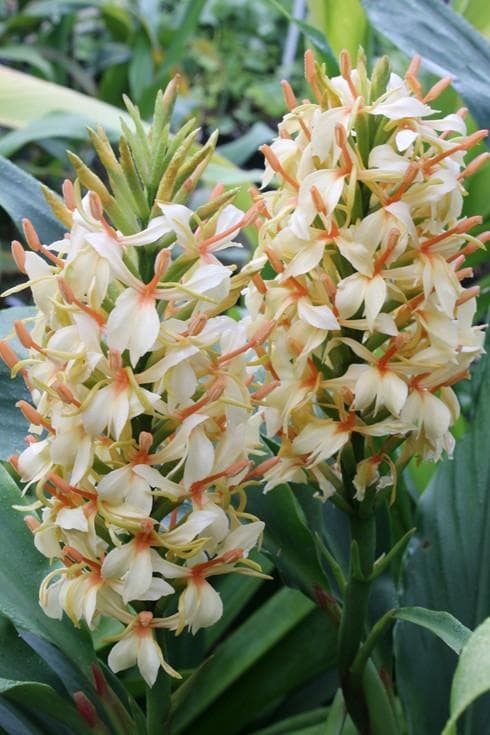Roscoea Roscoea 'Harvington Royale'

ABOUT
Roscoea 'Harvington Royale' is a striking perennial plant that features a cluster of lance-shaped, glossy green leaves that form an attractive base. The foliage provides a lush backdrop to the star of the show, which are the exquisite flowers it produces. These blossoms are shaped like elongated trumpets or funnel-shaped, and they usually appear in a captivating deep purple hue, often with a paler or white throat. The contrast between the dark outer petals and the lighter interior can be quite dramatic, making the flowers stand out with a royal-like presence. The blooms are arranged in succession along the stems, creating a progressive display of color as they open over time. It should be noted that the stems of Roscoea 'Harvington Royale' are sturdy and upright, holding the elegant flowers aloft above the leaves, adding to the plant's overall grace and charm. This plant typically blooms during the summer months, adding a pop of rich color to gardens during this season.
About this plant
 Names
NamesFamily
Zingiberaceae.
Synonyms
Hardy Ginger, Ginger Lily, Himalayan Ginger.
Common names
Roscoea 'Harvington Royale'.
 Toxicity
ToxicityTo humans
There is limited specific information available regarding the toxicity of Roscoea 'Harvington Royale', commonly known as Roscoea, to humans. However, the genus Roscoea typically does not appear on lists of plants known to be toxic to humans. While it is generally advised to avoid ingesting plants that are not established as being edible, if someone were to ingest parts of Roscoea and experiences symptoms such as nausea, vomiting, or diarrhea, it would be prudent to seek medical advice.
To pets
Information about the toxicity of Roscoea 'Harvington Royale', commonly referred to as Roscoea, to pets is not well-documented. Roscoea species are not typically known to be toxic to pets, but as with humans, it is generally wise to prevent pets from ingesting plants not recognized as safe for consumption. If a pet were to ingest parts of Roscoea and show signs of distress, such as vomiting, diarrhea, or unusual behavior, it would be best to consult a veterinarian.
 Characteristics
CharacteristicsLife cycle
Perennials
Foliage type
Deciduous
Color of leaves
Green
Flower color
Purple
Height
1-2 feet (30-60 cm)
Spread
0.5-1 feet (15-30 cm)
Plant type
Herb
Hardiness zones
6
Native area
Himalayas
Benefits
 General Benefits
General Benefits- Aesthetic appeal: The Roscoea 'Harvington Royale', commonly referred to as Roscoea, blooms with striking purple flowers that enhance the visual beauty of any garden or landscape setting.
- Low maintenance: The plant is relatively low maintenance, requiring minimal care once established, making it an ideal choice for gardeners of all skill levels.
- Drought tolerance: Roscoea is suitable for gardens with less frequent watering schedules, as it has a good level of drought tolerance.
- Pest resistance: The plant is known for having a natural resistance to many pests, reducing the need for chemical treatments.
- Attracts pollinators: The vibrant flowers attract bees and other pollinators, which are essential for the pollination of many plants and the overall health of the garden ecosystem.
- Long blooming season: Roscoea typically enjoys a long blooming season, providing color and interest in the garden for an extended period.
- Versatility in garden design: This plant can be used in a variety of garden designs, including borders, rock gardens, and woodland settings, offering flexibility in landscaping.
- Compact habit: With its compact growing habit, Roscoea 'Harvington Royale' is suitable for small gardens or spaces where a larger plant might be overwhelming.
- Cold hardiness: The plant is cold hardy to a certain extent, making it capable of surviving in climates with cooler temperatures.
 Medical Properties
Medical PropertiesThis plant is not used for medical purposes.
 Air-purifying Qualities
Air-purifying QualitiesThis plant is not specifically known for air purifying qualities.
 Other Uses
Other Uses- Roscoea can be used in themed gardens, like Asian or Himalayan-inspired landscapes, as they originate from these regions, adding authenticity and a touch of the exotic to garden designs.
- The flowers can serve as a delicate source of nectar for pollinators like bees and butterflies, playing a role in supporting local ecosystems.
- Artists and photographers may find Roscoea's unique flowers a compelling subject for their work, providing vibrant, intricate details for their compositions.
- The plant's bright flowers can be used as natural dye sources, often yielding various shades of yellows and oranges depending on the mordants used.
- Roscoea leaves can be used in the practice of leaf pressing or herbarium specimen creation, contributing educational material for botany enthusiasts.
- Culinary enthusiasts may explore the use of Roscoea's petals in salads to add a pop of color and a hint of texture to their dishes.
- Its robust rhizomes can be studied for their structural adaptations, providing insights for botanists into plant survival tactics in mountainous terrains.
- In folklore and storytelling, Roscoea can symbolize rare beauty or hidden strength, due to their survival in harsh high altitude environments.
- In some cultures, Roscoea plants could be incorporated into festivals or celebrations as part of floral displays or garlands representing certain themes or local flora.
- Gardeners may use Roscoea's growth habit for ground cover in shaded garden areas, as they do not require full sun and can fill in space with their lush foliage.
Interesting Facts
 Feng Shui
Feng ShuiThe Roscoea is not used in Feng Shui practice.
 Zodiac Sign Compitability
Zodiac Sign CompitabilityThe Roscoea is not used in astrology practice.
 Plant Symbolism
Plant Symbolism- Rarity: Roscoea 'Harvington Royale', a hybrid plant, is less common than other garden plants, representing something unique or rare in one's life.
- Exotic Beauty: The plant's striking appearance can symbolize exotic beauty and charm, often associated with the allure of the unfamiliar or foreign.
- Adaptation: Given that Roscoea species are originally from the Himalayas and can adapt to various climates, they may represent the ability to thrive in different environments or situations.
- Resilience: Their hardiness and ability to grow in challenging conditions may also symbolize resilience and the strength to overcome adversity.
- Uniqueness: Every variety of Roscoea, including 'Harvington Royale', has its unique traits, which can symbolize the value of individuality and personal uniqueness.
 Water
WaterRoscoea, commonly known as ginger lily, requires even moisture during its active growing season in spring and summer. A general recommendation is to water this plant once a week, providing about 1 gallon of water to ensure that the soil remains consistently damp but not soggy. During hot, dry periods, watering frequency may need to increase. In the winter, reduce watering to every other week or less, as the plant's water requirements decrease when it's not in active growth.
 Light
LightGinger lily thrives best in partial shade, where it can receive bright, indirect sunlight. Ideal planting spots are those that are shielded from the harsh midday sun, perhaps under a canopy of trees or on the east side of a structure where it gets morning light and afternoon shade. Too much direct sun can scorch the leaves, while too little can reduce flowering.
 Temperature
TemperatureThe ginger lily prefers temperate conditions and performs best in an environment where temperatures range between 50°F and 70°F. It can endure minimum temperatures down to about 40°F but should be protected from frost. During the active growing season, maintain temperatures within this ideal range for best growth and flowering.
 Pruning
PruningPruning ginger lily is mainly done to remove spent flower stalks and to tidy up the plant's appearance. It's best to prune it after flowering, typically in the late summer or early fall. Cut back the flower stems to the base of the plant to encourage future blooms and to maintain a neat appearance. Prune any damaged or withered leaves as needed to keep the plant healthy.
 Cleaning
CleaningAs needed
 Soil
SoilThe best soil mix for Roscoea purpurea 'Harvington Royale', commonly known as Hardy Ginger, should be rich, well-draining, and have high organic matter content. A mix of loam, sand, and peat or compost would be ideal. The pH should be slightly acidic to neutral, ranging from 6.0 to 7.0.
 Repotting
RepottingHardy Ginger should be repotted every 2 to 3 years or when it becomes root-bound. Use a slightly larger pot each time to allow for growth.
 Humidity & Misting
Humidity & MistingHardy Ginger prefers moderate humidity, around 40-60%. Avoid placing it in overly dry environments, as consistent humidity is beneficial for healthy growth.
 Suitable locations
Suitable locationsIndoor
Place Hardy Ginger in bright, indirect light indoors.
Outdoor
Plant Hardy Ginger in partial shade outdoors.
Hardiness zone
6-9 USDA
 Life cycle
Life cycleThe Roscoea 'Harvington Royale', commonly known as Roscoea, begins its life cycle as a rhizome, which is a type of underground stem that sends out roots and shoots from its nodes. In spring, new shoots emerge from the rhizome, typically producing lance-shaped leaves that form a loose rosette. As the plant matures, it sends up flower stems that bear exotic-looking, orchid-like flowers usually in shades of purple or violet, and this flowering stage can occur from late spring to summer depending on the climate. After pollination, flowers produce capsules containing seeds, which, when ripe, can be dispersed by wind or wildlife. Once the above-ground parts of the plant die back in late autumn, the plant enters a period of dormancy during winter. The rhizome survives underground throughout the cold months, ready to regenerate the next spring and complete the cycle.
 Propogation
PropogationPropogation time
Late Summer-Early Autumn
Propogation: Roscoea 'Harvington Royale', commonly known as Roscoea, is best propagated by division. This method should be performed in the spring just before the new growth starts. To propagate by division, carefully dig up the established clump of the plant, ensuring minimal root disturbance. Then gently separate the rhizomes, making sure that each division has at least one growth bud. Replant the divisions at the same depth they were growing previously, spacing them about 12 to 15 inches (30 to 38 centimeters) apart to allow room for growth. Water the new divisions well after planting to help establish them. This technique allows the gardener to create new plants that are genetically identical to the parent, thus maintaining the specific characteristics of the 'Harvington Royale' cultivar.
